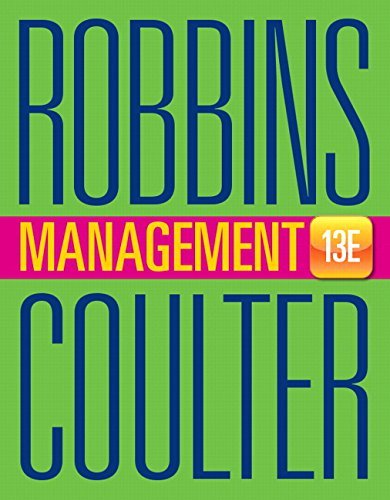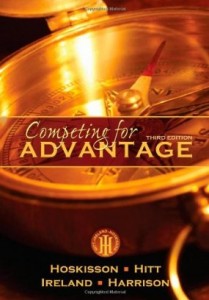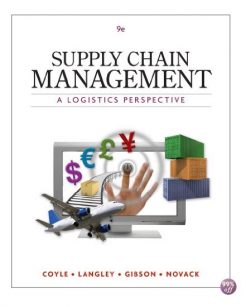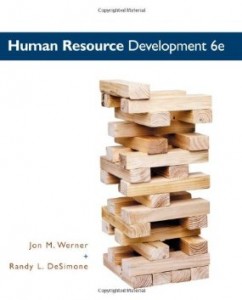Description
Management, 13e (Robbins)
Chapter 3 Managing the External Environment and the Organization’s Culture
1) Which of the following represents the two views of managerial impact on the success or failure of the organization?
- A) omnipotent and symbolic
- B) omnipotent and reflective
- C) symbolic and interactive
- D) reflective and interactive
Answer: A
Diff: 1
AACSB: Reflective thinking
Learning Obj.: LO 3.1: Contrast the actions of managers according to the omnipotent and symbolic views
Classification: Concept
2) The dominant view in management theory suggests that ________.
- A) an organization’s success or failure is due to external forces outside managers’ control
- B) managers’ roles are increasingly becoming peripheral and staff manage their own areas of expertise
- C) managers are directly responsible for an organization’s success or failure
- D) managers cannot significantly affect an organization’s performance because they are constrained by the abilities of their employees
Answer: C
Diff: 2
AACSB: Reflective thinking
Learning Obj.: LO 3.1: Contrast the actions of managers according to the omnipotent and symbolic views
Classification: Concept
3) Wendell notices that the company’s top executives share a belief that managers are directly responsible for the organization’s success or failure. This belief reflects a(n) ________ view of management.
- A) traditional
- B) omnipotent
- C) reflective
- D) symbolic
Answer: B
Diff: 1
AACSB: Reflective thinking
Learning Obj.: LO 3.1: Contrast the actions of managers according to the omnipotent and symbolic views
Classification: Application
4) Wendell interviews many middle-level managers and discovers that they share a different view of management. These individuals believe that external factors constrain managers’ influence over outcomes. The mid-level managers have a(n) ________ view of management.
- A) traditional
- B) omnipotent
- C) reflective
- D) symbolic
Answer: D
Diff: 1
AACSB: Application of knowledge
Learning Obj.: LO 3.1: Contrast the actions of managers according to the omnipotent and symbolic views
Classification: Application
5) Calvin’s goals for the coming year include specific targets for increasing market share and quantity of units shipped. If he succeeds, he will be handsomely rewarded. If he fails, he is likely to be replaced. Judging from this, it would appear that Calvin’s employer subscribes to ________.
- A) the symbolic view of management
- B) the omnipotent view of management
- C) the impotent view of management
- D) the omniscient view of management
Answer: B
Diff: 2
AACSB: Application of knowledge
Learning Obj.: LO 3.1: Contrast the actions of managers according to the omnipotent and symbolic views
Classification: Application
6) Which of the following most accurately reflects the symbolic view of management?
- A) Managers are directly responsible for an organization’s success or failure.
- B) Managers have to ensure that every obstacle is overcome on the way to achieving the organization’s goals.
- C) External forces are responsible for an organization’s success or failure.
- D) Employees are directly responsible for an organization’s success or failure.
Answer: C
Diff: 2
AACSB: Reflective thinking
Learning Obj.: LO 3.1: Contrast the actions of managers according to the omnipotent and symbolic views
Classification: Concept
7) Elmo Research & Development has been going through a rough patch lately. Turnover has been high and employee morale is at an all-time low. Though employees and competitors hold management responsible for the decline, the CEO does not let the managers go or change the management style. Which of the following could explain this attitude?
- A) The CEO holds the omnipotent view of management, which asserts that external factors have a significant effect on performance outcomes.
- B) Because the organization has a “take-charge” management style, the employees are responsible for organizational policies.
- C) The CEO is unresponsive to the criticisms from stakeholders.
- D) The CEO holds the view that managers have only a limited role in organization success or failure.
Answer: D
Diff: 2
AACSB: Application of knowledge; Analytical thinking
Learning Obj.: LO 3.1: Contrast the actions of managers according to the omnipotent and symbolic views
Classification: Application; Analytical
8) The ________ view of management is consistent with the stereotypical picture of the take-charge business executive who can overcome any obstacle in carrying out the organization’s objectives.
- A) omnipotent
- B) impotent
- C) omniscient
- D) symbolic
Answer: A
Diff: 2
AACSB: Reflective thinking
Learning Obj.: LO 3.1: Contrast the actions of managers according to the omnipotent and symbolic views
Classification: Concept
9) The soccer league in England is notorious for the number of team managers fired over the course of a single season, which stands at no fewer than eight managers on average, owing to poor team form and consequently, poor results. It is evident from this information that the league endorses a(n) ________ view of management.
- A) symbolic
- B) omnipotent
- C) impotent
- D) omniscient
Answer: B
Diff: 2
AACSB: Application of knowledge; Analytical thinking
Learning Obj.: LO 3.1: Contrast the actions of managers according to the omnipotent and symbolic views
Classification: Application of knowledge; Analytical thinking
10) According to the symbolic view, managers have a(n) ________ effect on substantive organizational outcomes.
- A) limited
- B) extensive
- C) influential
- D) significant
Answer: A
Diff: 1
AACSB: Reflective thinking
Learning Obj.: LO 3.1: Contrast the actions of managers according to the omnipotent and symbolic views
Classification: Concept
11) The symbolic view of management is based upon the belief that managers symbolize ________.
- A) control and influence in developing plans and making decisions
- B) every aspect of an organization’s performance, from the top level to the operational level
- C) the fluctuating fortunes of the organization as they alternate between profits and losses
- D) the take-charge executive who overcomes any obstacle to see that the organization achieves its goals
Answer: A
Diff: 2
AACSB: Reflective thinking
Learning Obj.: LO 3.1: Contrast the actions of managers according to the omnipotent and symbolic views
Classification: Concept
12) Internal constraints that influence managers’ decisions and actions come from ________.
- A) the attitudes of customers
- B) the culture of the organization
- C) the prevailing political conditions
- D) the fluctuations in the stock market
Answer: B
Diff: 2
AACSB: Reflective thinking
Learning Obj.: LO 3.1: Contrast the actions of managers according to the omnipotent and symbolic views
Classification: Concept
13) In the symbolic view of management, managers are seen as directly responsible for an organization’s success or failure.
Answer: FALSE
Diff: 1
AACSB: Reflective thinking
Learning Obj.: LO 3.1: Contrast the actions of managers according to the omnipotent and symbolic views
Classification: Concept
14) The view of managers as omnipotent is consistent with the stereotypical picture of the take-charge business executive who can overcome any obstacle in carrying out the organization’s objectives.
Answer: TRUE
Diff: 1
AACSB: Reflective thinking
Learning Obj.: LO 3.1: Contrast the actions of managers according to the omnipotent and symbolic views
Classification: Concept
15) The symbolic view of management impact is useful in explaining the high turnover among sports coaches, who can be considered the “managers” of their teams.
Answer: FALSE
Diff: 1
AACSB: Reflective thinking
Learning Obj.: LO 3.1: Contrast the actions of managers according to the omnipotent and symbolic views
Classification: Concept
16) In a short essay, differentiate between the symbolic view and the omnipotent view of management. Include specific examples of each view to support your answer.
Answer:
- In the omnipotent view, differences in an organization’s performance are assumed to be due to decisions and actions of its managers. Good managers anticipate change, exploit opportunities, correct poor performance, and lead their organizations. When things go well and profits are up, managers take the credit and are rewarded – even if they had little to do with achieving the positive outcomes. When profits are down, top managers are often fired in the belief that “new blood” will bring improved results. Coaches are often released following a poor season as they are considered the “managers” of their teams.
- The symbolic view holds that a manager’s ability to affect performance outcomes is influenced and constrained by external factors. According to this view, it’s unreasonable to expect managers to significantly affect an organization’s performance. Instead, performance is influenced by factors over which managers have little control such as the economy, customers, governmental policies, competitors’ actions, industry conditions, and decisions made by previous managers. This view is labeled “symbolic” because it’s based on the belief that managers symbolize control and influence by developing plans, making decisions, and engaging in other managerial activities to make sense out of random, confusing, and ambiguous situations. However, the actual part that managers play in organizational success or failure is limited.
In the 1990s Cisco Systems was the picture of success. Growing rapidly, it was widely praised by analysts for its “brilliant strategy, masterful management of acquisitions and superb customer focus.” As Cisco’s performance declined during the early part of the 21st century, analysts said that its strategy was flawed, its acquisition approach was haphazard, and its customer service was poor. The symbolic view would suggest that declining performance was due to the external circumstances beyond the control of the managers.
Diff: 3
AACSB: Reflective thinking; Written and oral communication
Learning Obj.: LO 3.1: Contrast the actions of managers according to the omnipotent and symbolic views
Classification: Concept; Application
17) If mortgage interest rates increase, this would be an example of changing ________ in a firm’s external environment.
- A) economic conditions
- B) political conditions
- C) sociocultural conditions
- D) demographic conditions
Answer: A
Diff: 1
AACSB: Application of knowledge
Learning Obj.: LO 3.2: Describe the constraints and challenges facing managers in today’s external environment
Classification: Application
18) Which of the following factors is a demographic component of an organization’s external environment?
- A) lifestyles and behavior
- B) political stability
- C) geographic location
- D) stock market fluctuations
Answer: C
Diff: 2
AACSB: Reflective thinking
Learning Obj.: LO 3.2: Describe the constraints and challenges facing managers in today’s external environment
Classification: Concept
19) Which of the following factors is an economic component of an organization’s external environment?
- A) The employees of the organization have, on average, 2.3 children.
- B) The average customer of a firm has a high school education.
- C) The firm’s customers’ disposable income falls in the range of $25,000-$40,000.
- D) Most of the firm’s customers live in the Midwest.
Answer: C
Diff: 3
AACSB: Application of knowledge; Analytical thinking
Learning Obj.: LO 3.2: Describe the constraints and challenges facing managers in today’s external environment
Classification: Application; Analytical
20) The ________ component of an organization’s external environment is concerned with trends in population characteristics such as age, race, gender, education level, geographic location, income, and family composition.
- A) economic
- B) political
- C) demographic
- D) sociocultural
Answer: C
Diff: 2
AACSB: Reflective thinking
Learning Obj.: LO 3.2: Describe the constraints and challenges facing managers in today’s external environment
Classification: Concept
21) The Metropolis News has experienced a decline in the number of subscriptions to its printed newspaper over the last 5 years. It seems people prefer news feeds sent to their smartphones rather than a printed paper delivered to their homes. Which component in the external environment does this change represent?
- A) economic
- B) psychological
- C) demographic
- D) sociocultural
Answer: D
Diff: 3
AACSB: Application of knowledge
Learning Obj.: LO 3.2: Describe the constraints and challenges facing managers in today’s external environment
Classification: Application
22) Which of the following factors is a sociocultural component of an organization’s external environment?
- A) Most of the firm’s customers have at least one year of college.
- B) The government of the country holds elections whenever confidence in the current regime falters.
- C) Over time, society has become more accepting of alternative lifestyles.
- D) The birth rate of the country is declining.
Answer: C
Diff: 3
AACSB: Application of knowledge; Analytical thinking
Learning Obj.: LO 3.2: Describe the constraints and challenges facing managers in today’s external environment
Classification: Application; Analytical
23) Suppose the government of Abolonia imposed a national sales tax on its citizens that reduced their disposable income. Which component of the external environment would this affect?
- A) global
- B) political/legal
- C) demographic
- D) economic
Answer: D
Diff: 3
AACSB: Application of knowledge
Learning Obj.: LO 3.2: Describe the constraints and challenges facing managers in today’s external environment
Classification: Application
24) The citizens of Abolonia believe no top executive should ever earn more than 40 times the average wage of the company’s employees. This is an example of ________.
- A) how changes in the demographics limit the discretion managers have
- B) how societal attitudes in the economic context create constraints on the decisions managers make
- C) how government regulation affects the salaries executives can earn
- D) a trend in the sociocultural environment that limits disposable income in the economic environment
Answer: B
Diff: 3
AACSB: Application of knowledge
Learning Obj.: LO 3.2: Describe the constraints and challenges facing managers in today’s external environment
Classification: Application
25) Which of the following groups includes individuals who were born between the years 1978-1994?
- A) the Gen X-ers
- B) the Gen Y-ers
- C) the Baby Boomers
- D) Pre-Millenials
Answer: B
Diff: 2
AACSB: Reflective thinking; Diverse and multicultural work environments
Learning Obj.: LO 3.2: Describe the constraints and challenges facing managers in today’s external environment
Classification: Concept
26) ________ are called the iGeneration, because they’ve grown up with technology that customizes everything to the individual.
- A) Post-Millennials
- B) Pre-Millennials
- C) Baby Boomers
- D) Gen Y-ers
Answer: A
Diff: 2
AACSB: Reflective thinking; Diverse and multicultural work environments
Learning Obj.: LO 3.2: Describe the constraints and challenges facing managers in today’s external environment
Classification: Concept
27) Which of the following, if true, represents a demographic change that will affect decisions future managers make?
- A) The unemployment rate is likely to continue to fall.
- B) The percentage of Hispanics in the candidate pool will increase.
- C) More job candidates are likely to have tattoos and body piercings.
- D) More jobs will be performed by robots.
Answer: B
Diff: 2
AACSB: Diverse and multicultural work environments; Application of knowledge; Analytical thinking
Learning Obj.: LO 3.2: Describe the constraints and challenges facing managers in today’s external environment
Classification: Application; Analytical
28) Assume the global economy rebounds rapidly from the Great Recession. What constraint is this likely to have on decisions managers make?
- A) Qualified job candidates will become fewer and fewer.
- B) Managers will be asked to eliminate positions to cut labor costs.
- C) The hourly compensation average will have to fall; managers will be asked to offer less to job candidates.
- D) Positions will be easier to fill as college graduates settle for lower paying jobs.
Answer: A
Diff: 2
AACSB: Application of knowledge; Analytical thinking
Learning Obj.: LO 3.2: Describe the constraints and challenges facing managers in today’s external environment
Classification: Application; Analytical
29) If the components of an organization’s environment change frequently, the organization is operating in a ________ environment.
- A) stable
- B) simple
- C) dynamic
- D) complex
Answer: C
Diff: 1
AACSB: Reflective thinking
Learning Obj.: LO 3.2: Describe the constraints and challenges facing managers in today’s external environment
Classification: Concept







Reviews
There are no reviews yet.